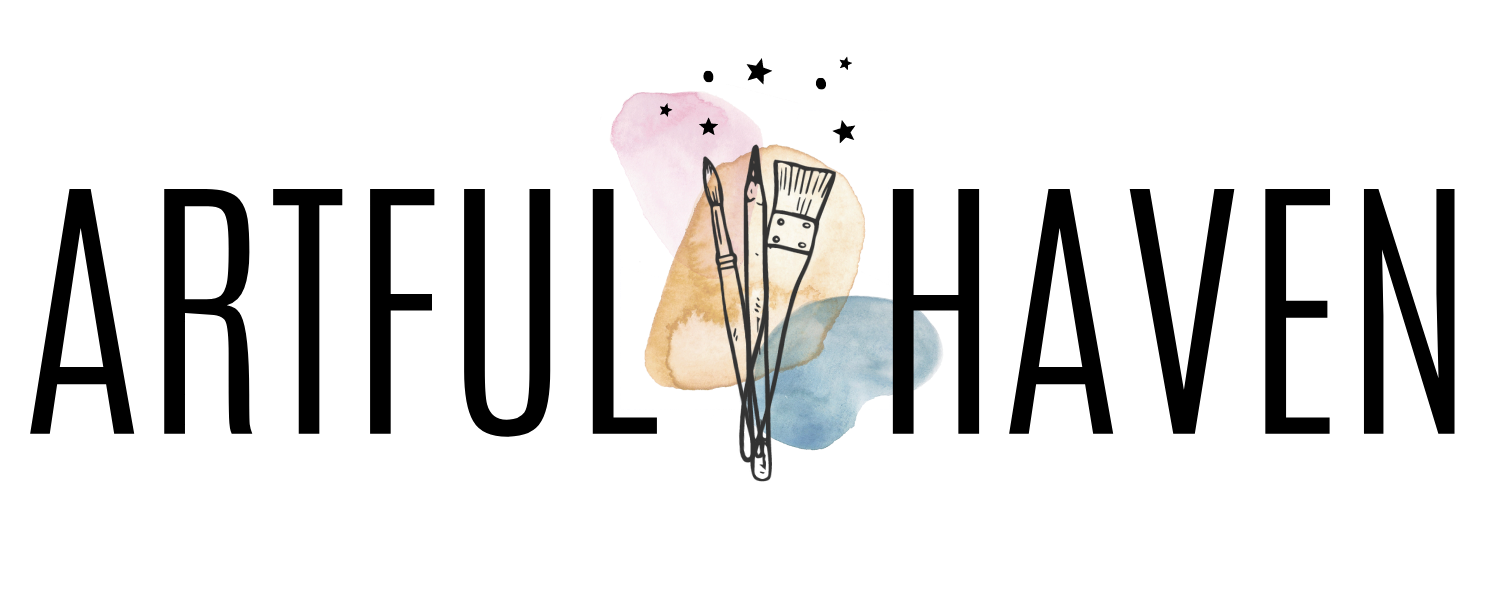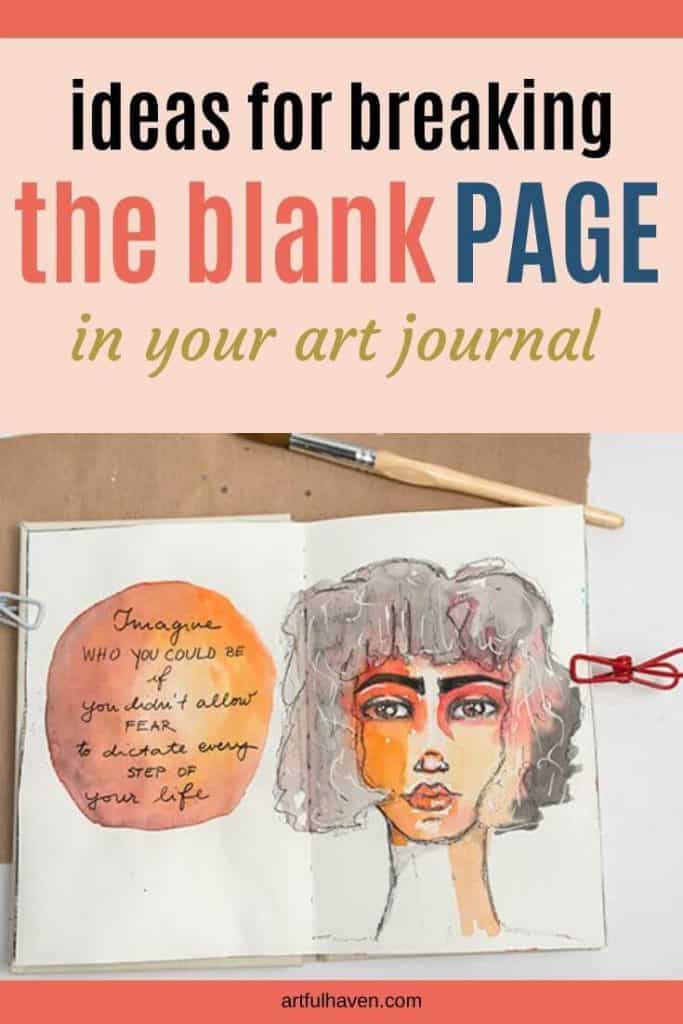Breaking the Blank Page: 13 Inspirational Art Journal Ideas
Is it one of your most annoying struggles to actually start that page in your art journal? Does the blank page stare at you mocking?
It seems to me you’re suffering from the fear of the blank page. Yep! It’s a syndrome. Writers have it, too.
And you won’t believe how common that is. It’s like stubborn flu infecting all artists at least once (oh, but it’s way more than once).
However, there are ways to break the blank page and overcome that fear.
That’s why I’m sharing some art journal ideas with you today. I want to inspire you to start that blank art journal page without any dramatic emotion commotion ending in you being disappointed or sad.
Disclaimer: Some links in this post may be affiliate links. This means that if you purchase something through that link, I get a small commission, at no extra cost to you.
Why does this fear of the blank page happen?
It’s the same story as with any other creative block. This annoying situation happens to writers, sportspeople, teachers, photographers, to anyone who wants to use their creativity with purpose and feels the need to be creative.
I read a great article on Psychology Today about creativity. The authors, D. Goleman and P. Kaufman make good points about creativity and the lack of it. Their insights stuck with me because I’ve felt uncreative many times in my life. (Like, many, many times.)
Here are some of their points, and my own follow-ups.
We compare ourselves to others
They argue that we are all creative but many of us just don’t see it because “we don’t have much of the audience for what we do“. What they mean is that we compare ourselves to already acknowledged artists, which is crazy!
Think about it, why would you be comparing your art to the art of an artist who exhibits in galleries or organizes art workshops every week?
We think mistakes are mistakes
This article states, based on research, that creative people make more mistakes than less creative people. But they call this a problem-solving situation.
I couldn’t agree more.
So, when you experiment and make mistakes, you’re learning new ways of dealing with a problem.
Although these mistakes can seem like failures, they’re actually chances to learn and grow.
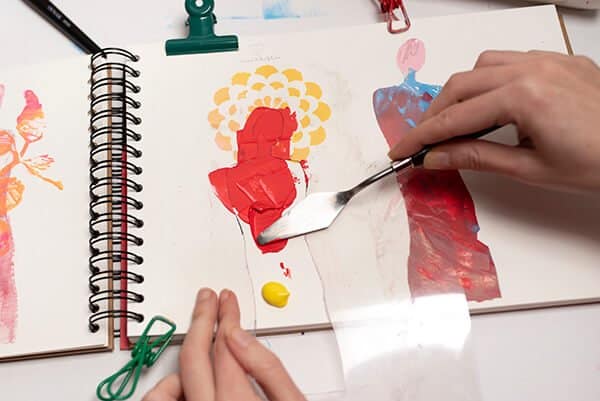
Would you know the light if there was no dark? You wouldn’t even know that the light exists because there would be nothing to compare it to. The black exists to define the white, and vice versa.
Your mistakes on the paper give you a wonderful opportunity to grow. Use them like that, and not judge yourself.
Just an example. If you try mixing two colors and realize you don’t like that, you sure as hell learned how these colors mix, and you’ll be more aware of it next time.
If you make no mistakes, what can you possibly learn?
We forget to play
Continuing in their article, they argue that if you play when you create and enjoy humor more, then your creativity flourishes.
And we often forget to play in our art journals, that’s why we’ve got that fear of the blank page. If the fear is there, the whole situation seems so serious and consequently overwhelming.
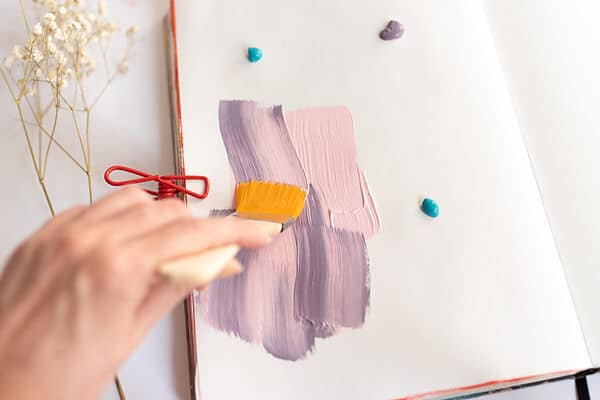
Among other beautiful things, art journaling has helped me see my art-making as something incredibly fun.
Making all those art journal pages, and having alone time with my inner artist, is like an artsy party where you don’t worry about adult life but just behave like a playful child with a brush in your hand.
Ideas for breaking the blank page in your art journal
Here, I’ll share some ideas I usually use that have helped me start that blank page.
If you try just one and unleash your creativity, you’ll do a wonderful thing for yourself.
I’d like you to try at least the first three ideas. These have helped me break the blank page many times. They really work.
We’ll cover these ideas:
1. Experiment with your art journal supplies
2. Embrace your mistakes
3. Use art journal prompts
4. Change your environment
5. Break the blank page by setting limits
6. Get inspired by music
7. Do something beyond your routine
8. Play like a child
9. Make an art journal without blank pages
10. Face the blank page with collaging
11. Try using a smaller art journal
12. Tidy your art supplies
13. Organize an art journaling party
1. Experiment with your art journal supplies
This is my favorite defense against that white, blank page.
Whenever I feel stuck, I just go and experiment.
I might try my new paints or just see how a paintbrush leaves a mark.
Also, I sometimes just try out some stamps and end up having an interesting background.
Another idea is to do swatches. Take your watercolors, for example, and try every color on a page, or mix colors to see what happens. Make notes of the mixes you’ve done for future reference.
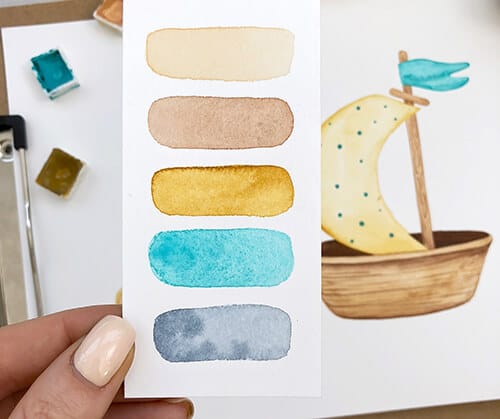
These swatches can also serve as a nice background later.
2. Embrace your mistakes
I’ve already mentioned how mistakes can be chances to learn and grow.
Mistakes are the result of your experimenting, and sometimes you won’t like what you get, and that’s great! Now you know you don’t like that.
For instance, you want to paint a page black and red and see what happens, and how the two work together. However, you end up hating the combination, and you see it as a mistake.
But, what if you see it as a great insight: you just don’t like the look of black and red together.
Perhaps you’ll like it better if you add some yellow. And bam! You turn your mistakes into valuable information about what you like and don’t like.
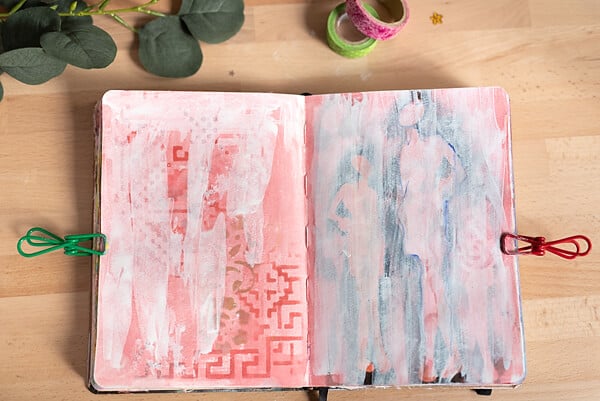
Once, when I was having an art party with my 2 girlfriends, one of them tried to paint with watercolor and a stencil with circles. I must admit that I was watching her bold adventure with a bit of suspicion: She’s going to make a bloody mess.
Then when she lifted her stencil she said something like: Oh, I blew it. The paint bled through the stencil and left uneven and blobby marks.
For a second, I nodded to myself in agreement. But then, something struck me. Those blobs were marvelous!
Why?
Because she used more than one color, and these colors bled into each other making beautiful, abstract shapes. It was a feast for the eyes.
Can you see my point?
First, she and I thought that it was a big mistake but little did we know. This has taught me that something new and beautiful can emerge from the things we call mistakes.
And what have I learned? You can use watercolors with stencils, play around, and create abstract images.
3. Use art journal prompts
Prompts are amazing solutions for breaking the blank page in your art journal.
They’ve already been thought through for you, all you have to do is follow the prompt and make something awesome and unique with it.
The prompts can tell you what supplies to use, what colors to choose, or tell you a process to follow.
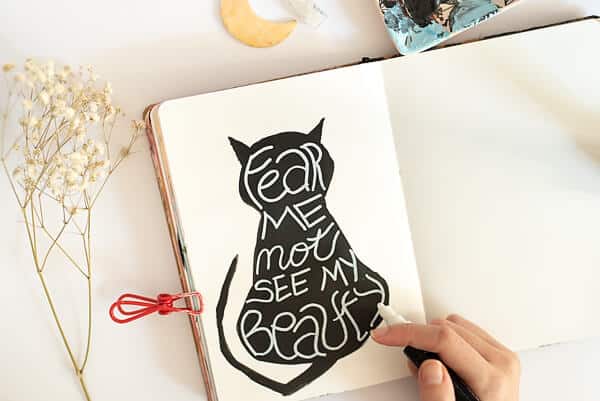
They can be very imaginative and interesting, easy and short, or require more time and supplies.
In any case, you can get a lot of inspiration by following art journal prompts.
If you want to try them out, I’ve got a few articles where you can find inspirational prompts to help you conquer the blank page. You can check my art journal prompts here.
4. Change your environment
The space we work or create in can sometimes slow us down in our creative thinking. It’s just because we get used to our surroundings and take them for granted.
How many things in your home do you notice as new and interesting on a daily basis? Well, hardly any unless you’ve just bought a new piece of furniture.
We get comfy with the familiar things and don’t think about them nor consider them inspiration in any way.
The same goes with the space you’re trying to create or paint in.
But what if you change the environment for creating in your art journal?
For me, it always helps to take my art journal and just go sit on the sofa. Somehow by changing the place for art, my creativity emerges more quickly.
I also like moving to my balcony if the weather lets me. Then I can see the mountains, the trees, the neighboring buildings, the birds flying, and so on.
Believe me, my inspiration surprises me when I do this. It’s amazing.
5. Breaking the blank page by setting limits
Although it may sound negative, but limiting yourself in art-making can result in amazing things. It’s like magic.
Do you often get overwhelmed by all the art supplies you have? You can have only five supplies and still feel that’s too much for you at once.
That’s why an amazing idea is just to choose a few supplies or set other limits while creating.
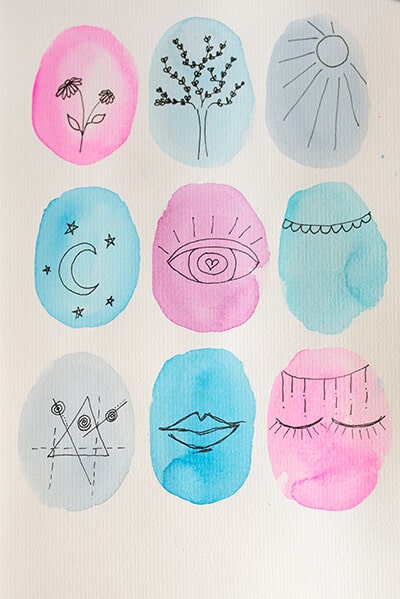
For example, you can limit your work to only 2 or three supplies. Let’s say you want to use only one stencil, a pen, and one color of acrylic paint.
No brushes or sponges? Then use your fingers and paint through the stencil. Add some marks with your pen.
Then add more marks with the pen and the stencil. Combine these three in any way you can think of and then see what you get and what you learn.
Another neat idea is to limit yourself to using only the color blue. You can use paper scraps, paints, inks, pens, anything as long as they’re blue.
You’re already interested, right?
6. Get inspired by music
I almost always listen to music when I create. It relaxes me and inspires me.
When you’re not feeling creative and stare at the blank page, put on some music.
It can be music that you like or any relaxing instrumental music.
Take your brush, dip it in acrylic paint, and make marks in the rhythm of the music. Then take another color and do the same.
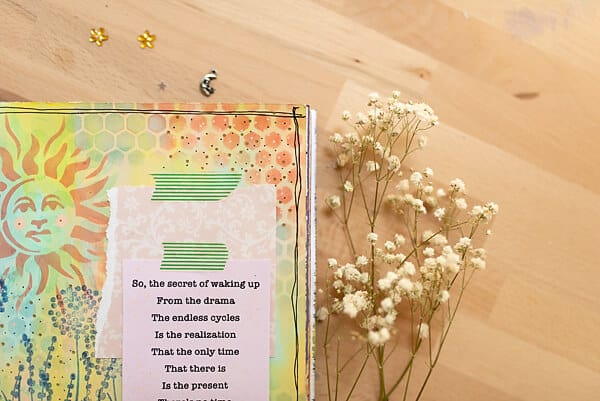
Try using blue for faster music and yellow for slower rhythm.
You’ll notice how you paint short marks to a faster beat and longer ones when the music is slower.
You just respond to anther piece of art and it inspires you by making you more mindful.
If you want to explore music and art journaling, check out this post that can give you some ideas on how to use lyrics and music to make art journal pages.
7. Do something beyond your routine
If you always start your pages with acrylic paint, do something completely different. Instead, begin with collaging.
When do you mostly create in your art journal? Mornings? Now try doing it in the evenings.
Bring your art journal to work if you’ve never done it before. When on a break, use it to record something or doodle something quickly about what happened at work.
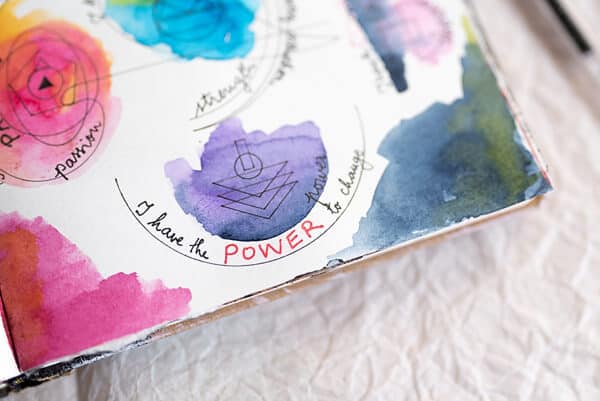
If you always start with the background first, why not begin your page by sketching something first, or vice versa.
Instead of writing with a pen, try writing with a brush.
Or, try drawing a simple flower with your non-dominant hand. This is such fun and it can become addictive. Now, after trying this, I’m obsessed with sketching faces with my left hand. And I love those sketches!
Just do something you usually don’t do. Even if it means turning your journal upside down, or trying out supplies that have been collecting dust for months.
8. Play like a child and paint the roof pink
Have you seen kids draw and paint?
They never say: Where should I start? Is this paint ok? What if I make a mistake? What if I don’t like it? Oh, even worse, what if others don’t like it?
They just start. As simple as that. And enjoy every bit of the process.
When I spend time with my niece doing art (she’s 5 years old), she usually gets so excited when I bring my colored pencils and say: Look how many pencils we have today!
She jumps with joy and says: Auntie, I’m gonna draw a big sun! And, and……I’m gonna draw a house and the roof will be pink! Pink, auntie!
Does she worry that it’s unlikely that anyone would paint their roof pink? She just doesn’t care. For her, it’s a game. It’s a fun time where she can create something and hang out with me. I love those moments.
So, when she makes the roof pink I envy her and then I learn from her. She’s having fun. Period.
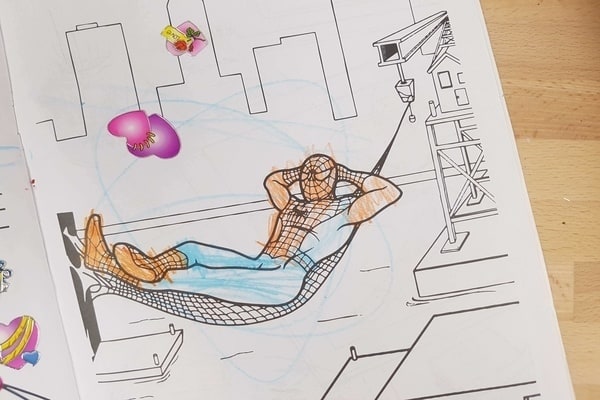
And when her little brother colors the Spiderman orange, laughing his head off because he thinks it’s funny (I mean really, an orange Spiderman?), I see that he’s having a blast across the table. I instantly want some of that.
Why not make art-making fun instead of going crazy over it like some serious business?
We usually stress about whether making art just for ourselves is a waste of time when we have more important things to do. We feel we shouldn’t even try to create something unless it’s some serious piece of art. Whaaat? No.
My point is you should try seeing your art journal as something fun you do for yourself. Decide you’re going to make art journaling a fun activity, a rare opportunity to play like a child.
Paint your roofs pink and your spidermen orange only because it’s fun!
9. Make an art journal without blank pages
This is a practical idea for having a journal that already has something in it. This way, there are no blank pages. You’ll already have some things on the paper and can use those.
For example, you can transform an old book into an art journal. The text and images in the book can serve as wonderful backgrounds and might just spark your creativity.
Another example is to make a DIY art journal with scrapbook paper or other patterned paper.
I’ve done this many times. I even included embossed and textured scrapbook papers, and they were interesting to work on.
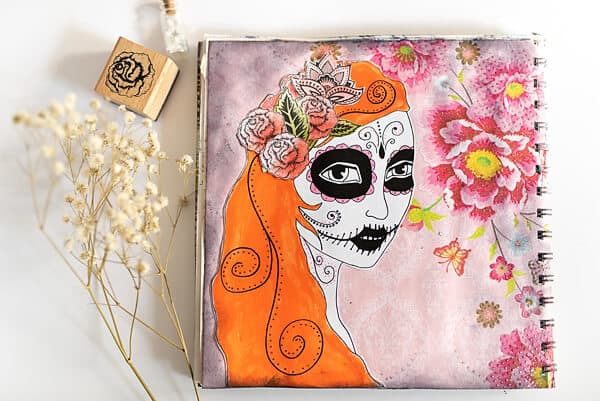
There are even papers that have beautiful drawings of people, places or things. Imagine making a journal with these.
Some paper companies make amazing designs, and if you want to check out some of them, I’ve found amazing papers on Scrapbook.com.
10. Breaking the blank page with collaging
In my experience, making collages is a great way of breaking the blank page. Similar to the idea above, you can use images and scraps that are already designed, and glue them down in your art journal.
Even more, when you start cutting out pictures from magazines, you’ll definitely get inspired just by looking at the images and arranging them.
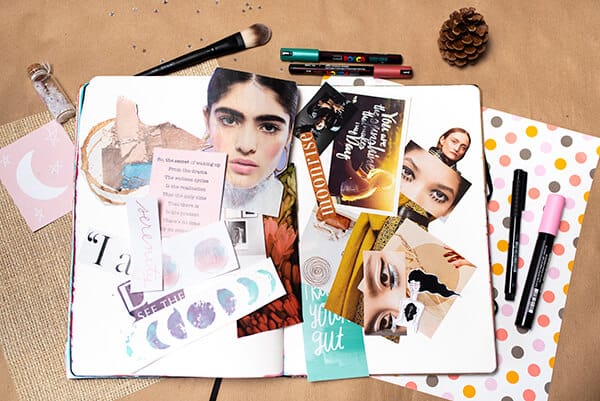
You can also cut out letters and words. Just make a little stash of these images and then when you feel stuck, go through them, choose the one that caught your eye, glue it down and continue from there.
I’m sure you’ll have at least one idea of what to do next.
You can use paper scraps and washi tape, too. Glue them down as you feel and see what you get in the end.
Even if you only glue a magazine picture and doodle on it with a marker, it’ll be something fantastic. Add a few words, express yourself, and ta-da! You’ve beaten the blank page.
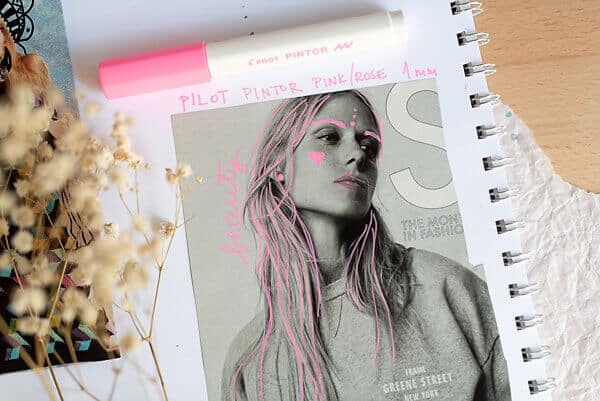
11. Try using a smaller art journal
The bigger the journal, the bigger your troubles.
Filling an A4 size page and a pocket-size journal page is very much different. In the larger journal, you’ll have to cover a whole lot of space. But in a smaller journal, everything is tinier and somehow cuter.
And what’s most important, the blank page in a smaller journal doesn’t look so terrifying, does it?
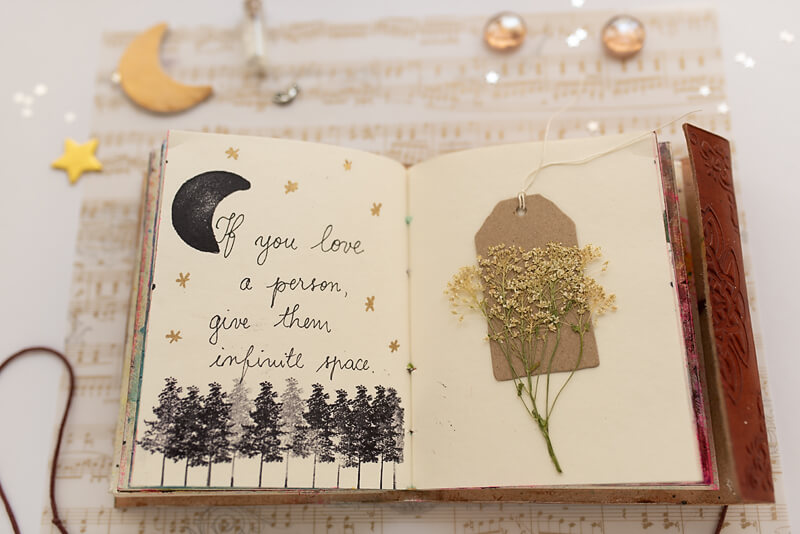
I’ve found that I create more easily in a smaller journal. Then I’m somehow not afraid of sketching, drawing, or ruining a page.
So, if you have blank page paralysis, think of how big your art journal is. Maybe you could try with a smaller one for a while.
12. Tidy your art supplies
This may sound weird. How can I tidy things and conquer the blank page?
The thing is, when you go through your art supplies to tidy them or arrange them, you can come across some things you even forgot you had.
Then you want to try them to see what they have to offer. The next thing you see is far from a blank page.
Another thing that can happen while tidying is getting inspired by an art supply.
What happened to me many times is discovering I have a wonderful shade of acrylic paint that I instantly love and want to try out on a page.
Sometimes when I arrange my stamps, I notice designs that inspire me to draw something, or I see a combination of stamps that would look good with each other.
These are wonderful moments of revelation and they wouldn’t have happened if I hadn’t decided to finally make some order in my messy art place.
13. Organize an art journaling party
In the article I mentioned at the beginning, the authors say that people can get more creative while collaborating with their peers, especially when they laugh and have fun together.
Having fun with people creates an easy-going atmosphere where you feel freer to express your ideas without the pressure to be perfect or right.
Also, if you hang out with artsy people like yourself, and you make art together, you get to inspire one another. You can easily get new ideas, learn new things, and have so much fun.
I used to meet with two of my friends and we would put all the supplies in the middle of the table and just start.
We talked and laughed, or even had moments of silence because we got engaged in our creation.
One of these friends tried stencils and watercolors, remember me mentioning it earlier? What a wonderful new technique to learn.
Final tips for breaking the blank page in your art journal
My best advice would be to see your art journals as books of artsy experiments. Play with your art supplies and experiment with them. This will always take you further than you expect.
Also, start small. If you start creating with an image in your head of a perfect whimsical portrait with vibrant colors, you’re focused on the end goal and it slows you right from the start.
But if you start small, with lines, dots, shapes, words, gluing scraps, bit by bit, you slowly create something without even expecting an end result that must be perfect.
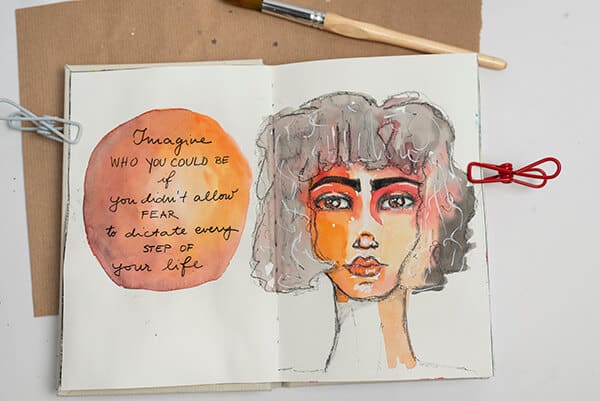
Another thing I’d like you to remember is to embrace your mistakes. The fear of making a mistake is what paralyzes you and breaking the blank page seems impossible, and even repulsive.
There are no mistakes. Only chances to learn and grow.
It’s really silly of you to expect yourself to be a perfect artist when nobody can even define the perfect.
For some, a perfect art journal page is a colorful mixed media page, but for somebody else, the perfect art journal page is a minimalist collage with journaling.
Who could argue which is more perfect than the other? This is silly.
If you open your art journal thinking you’ll experiment a bit and see what you’ll get, and what you’ll learn, then all the pressure is off, and the blank page isn’t that scary after all.
Grab your free Beginner’s Art Journal Starter Kit
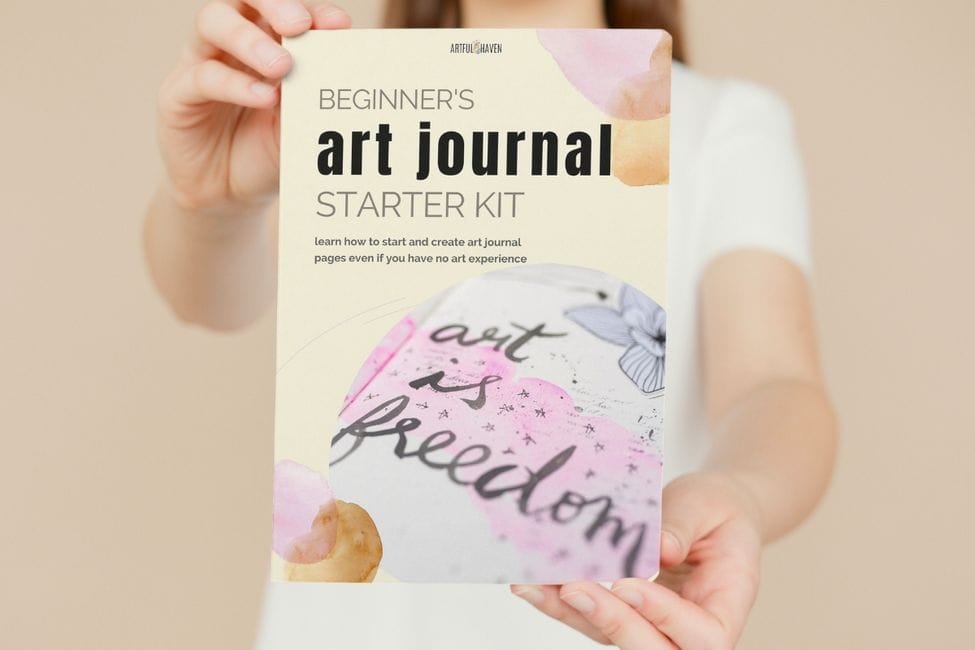
RELATED ART JOURNAL ARTICLES
30 Art Journal Prompts for Inspiration When You Feel Uncreative
How to Start an Art Journal Page: 7 Ideas You Can Do Right Now
Gratitude Journal Prompts: Art Journaling With Mindfulness
